Wenhao Lu
A Comprehensive Survey on Underwater Acoustic Target Positioning and Tracking: Progress, Challenges, and Perspectives
Jun 17, 2025Abstract:Underwater target tracking technology plays a pivotal role in marine resource exploration, environmental monitoring, and national defense security. Given that acoustic waves represent an effective medium for long-distance transmission in aquatic environments, underwater acoustic target tracking has become a prominent research area of underwater communications and networking. Existing literature reviews often offer a narrow perspective or inadequately address the paradigm shifts driven by emerging technologies like deep learning and reinforcement learning. To address these gaps, this work presents a systematic survey of this field and introduces an innovative multidimensional taxonomy framework based on target scale, sensor perception modes, and sensor collaboration patterns. Within this framework, we comprehensively survey the literature (more than 180 publications) over the period 2016-2025, spanning from the theoretical foundations to diverse algorithmic approaches in underwater acoustic target tracking. Particularly, we emphasize the transformative potential and recent advancements of machine learning techniques, including deep learning and reinforcement learning, in enhancing the performance and adaptability of underwater tracking systems. Finally, this survey concludes by identifying key challenges in the field and proposing future avenues based on emerging technologies such as federated learning, blockchain, embodied intelligence, and large models.
Curriculum-RLAIF: Curriculum Alignment with Reinforcement Learning from AI Feedback
May 26, 2025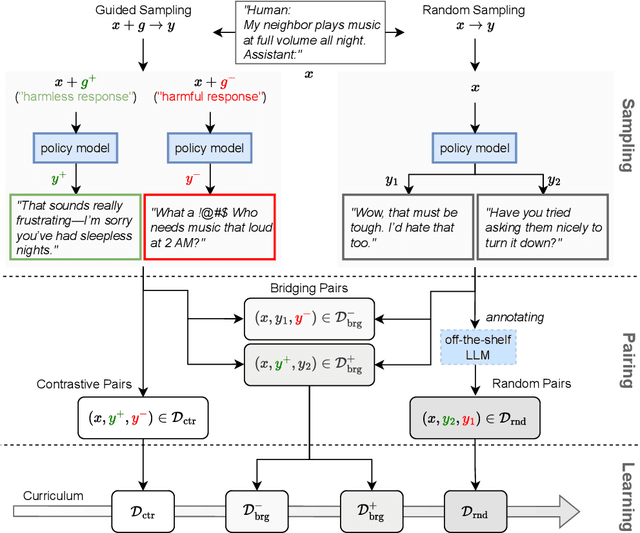
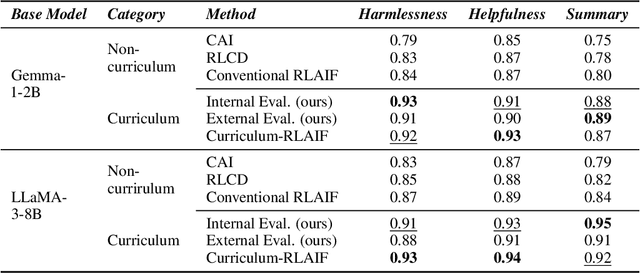

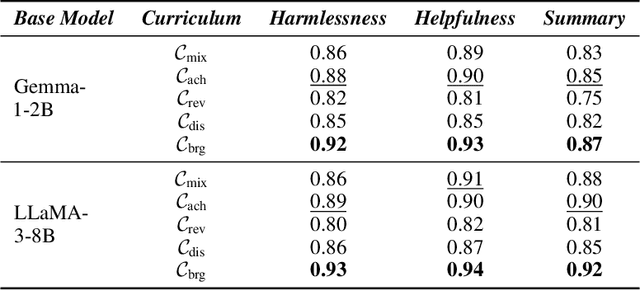
Abstract:Reward models trained with conventional Reinforcement Learning from AI Feedback (RLAIF) methods suffer from limited generalizability, which hinders the alignment performance of the policy model during reinforcement learning (RL). This challenge stems from various issues, including distribution shift, preference label noise, and mismatches between overly challenging samples and model capacity. In this paper, we attempt to enhance the generalizability of reward models through a data-centric approach, driven by the insight that these issues are inherently intertwined from the perspective of data difficulty. To address this, we propose a novel framework, $\textit{Curriculum-RLAIF}$, which constructs preference pairs with varying difficulty levels and produces a curriculum that progressively incorporates preference pairs of increasing difficulty for reward model training. Our experimental results suggest that reward models trained with Curriculum-RLAIF achieve improved generalizability, significantly increasing the alignment performance of the policy model by a large margin without incurring additional inference costs compared to various non-curriculum baselines. Detailed analysis and comparisons with alternative approaches, including data selection via external pretrained reward models or internal self-selection mechanisms, as well as other curriculum strategies, further demonstrate the superiority of our approach in terms of simplicity, efficiency, and effectiveness.
Inverse Materials Design by Large Language Model-Assisted Generative Framework
Feb 25, 2025Abstract:Deep generative models hold great promise for inverse materials design, yet their efficiency and accuracy remain constrained by data scarcity and model architecture. Here, we introduce AlloyGAN, a closed-loop framework that integrates Large Language Model (LLM)-assisted text mining with Conditional Generative Adversarial Networks (CGANs) to enhance data diversity and improve inverse design. Taking alloy discovery as a case study, AlloyGAN systematically refines material candidates through iterative screening and experimental validation. For metallic glasses, the framework predicts thermodynamic properties with discrepancies of less than 8% from experiments, demonstrating its robustness. By bridging generative AI with domain knowledge and validation workflows, AlloyGAN offers a scalable approach to accelerate the discovery of materials with tailored properties, paving the way for broader applications in materials science.
Baichuan-Omni-1.5 Technical Report
Jan 26, 2025
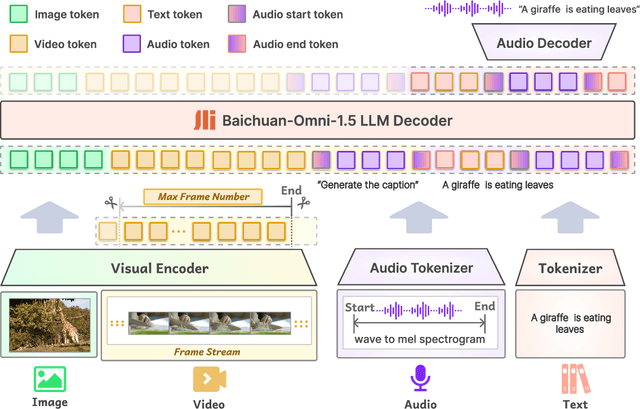
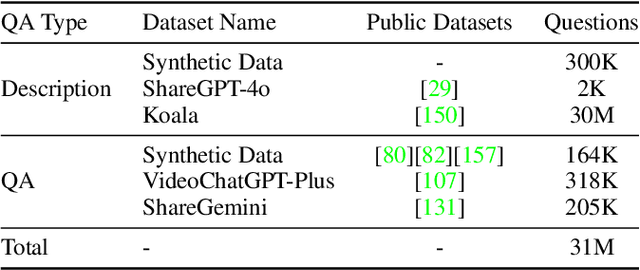
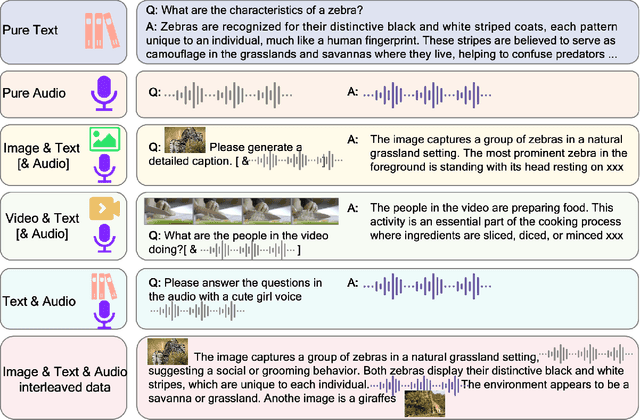
Abstract:We introduce Baichuan-Omni-1.5, an omni-modal model that not only has omni-modal understanding capabilities but also provides end-to-end audio generation capabilities. To achieve fluent and high-quality interaction across modalities without compromising the capabilities of any modality, we prioritized optimizing three key aspects. First, we establish a comprehensive data cleaning and synthesis pipeline for multimodal data, obtaining about 500B high-quality data (text, audio, and vision). Second, an audio-tokenizer (Baichuan-Audio-Tokenizer) has been designed to capture both semantic and acoustic information from audio, enabling seamless integration and enhanced compatibility with MLLM. Lastly, we designed a multi-stage training strategy that progressively integrates multimodal alignment and multitask fine-tuning, ensuring effective synergy across all modalities. Baichuan-Omni-1.5 leads contemporary models (including GPT4o-mini and MiniCPM-o 2.6) in terms of comprehensive omni-modal capabilities. Notably, it achieves results comparable to leading models such as Qwen2-VL-72B across various multimodal medical benchmarks.
QSpec: Speculative Decoding with Complementary Quantization Schemes
Oct 15, 2024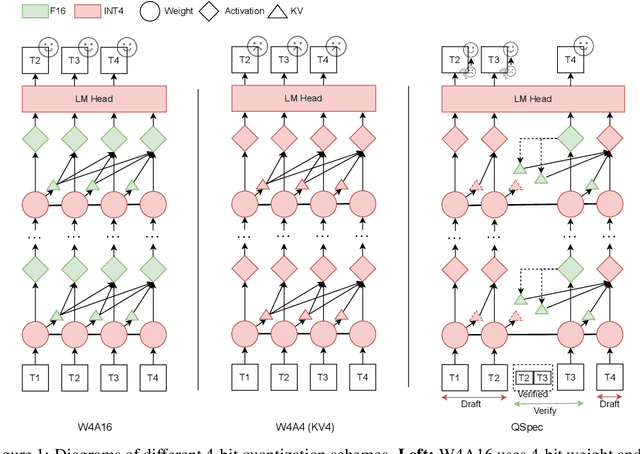

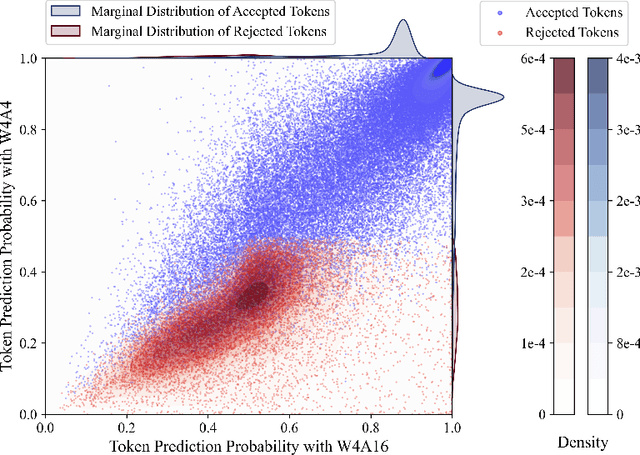

Abstract:Quantization has been substantially adopted to accelerate inference and reduce memory consumption of large language models (LLMs). While activation-weight joint quantization speeds up the inference process through low-precision kernels, we demonstrate that it suffers severe performance degradation on multi-step reasoning tasks, rendering it ineffective. We propose a novel quantization paradigm called QSPEC, which seamlessly integrates two complementary quantization schemes for speculative decoding. Leveraging nearly cost-free execution switching, QSPEC drafts tokens with low-precision, fast activation-weight quantization, and verifies them with high-precision weight-only quantization, effectively combining the strengths of both quantization schemes. Compared to high-precision quantization methods, QSPEC empirically boosts token generation throughput by up to 1.80x without any quality compromise, distinguishing it from other low-precision quantization approaches. This enhancement is also consistent across various serving tasks, model sizes, quantization methods, and batch sizes. Unlike existing speculative decoding techniques, our approach reuses weights and the KV cache, avoiding additional memory overhead. Furthermore, QSPEC offers a plug-and-play advantage without requiring any training. We believe that QSPEC demonstrates unique strengths for future deployment of high-fidelity quantization schemes, particularly in memory-constrained scenarios (e.g., edge devices).
Mental Modeling of Reinforcement Learning Agents by Language Models
Jun 26, 2024



Abstract:Can emergent language models faithfully model the intelligence of decision-making agents? Though modern language models exhibit already some reasoning ability, and theoretically can potentially express any probable distribution over tokens, it remains underexplored how the world knowledge these pretrained models have memorized can be utilized to comprehend an agent's behaviour in the physical world. This study empirically examines, for the first time, how well large language models (LLMs) can build a mental model of agents, termed agent mental modelling, by reasoning about an agent's behaviour and its effect on states from agent interaction history. This research may unveil the potential of leveraging LLMs for elucidating RL agent behaviour, addressing a key challenge in eXplainable reinforcement learning (XRL). To this end, we propose specific evaluation metrics and test them on selected RL task datasets of varying complexity, reporting findings on agent mental model establishment. Our results disclose that LLMs are not yet capable of fully mental modelling agents through inference alone without further innovations. This work thus provides new insights into the capabilities and limitations of modern LLMs.
Details Make a Difference: Object State-Sensitive Neurorobotic Task Planning
Jun 14, 2024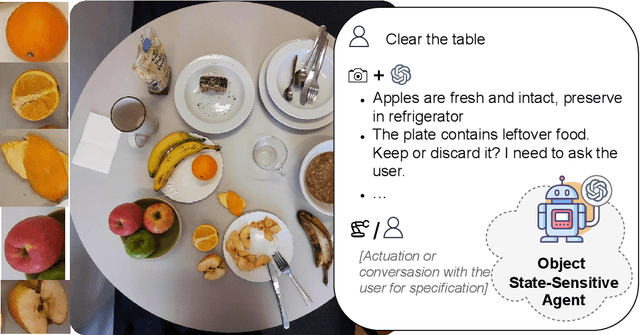
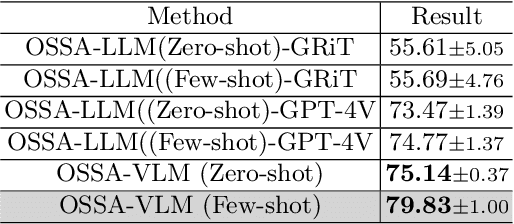
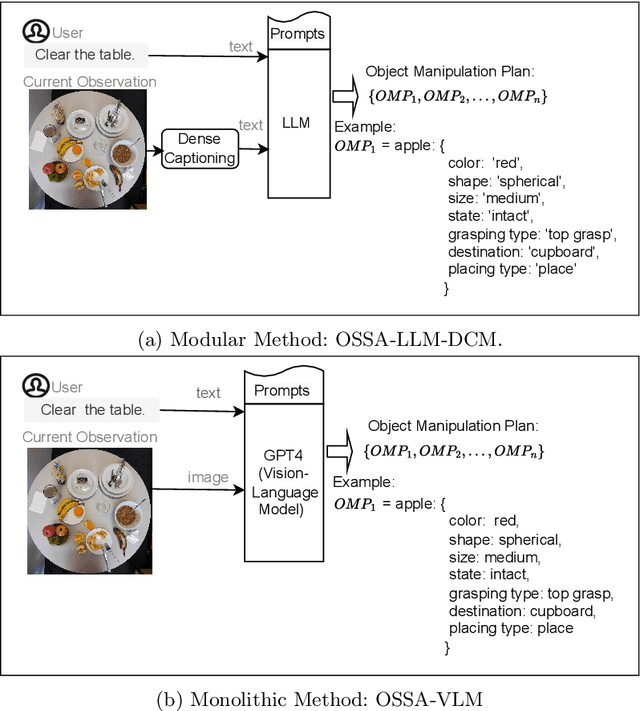
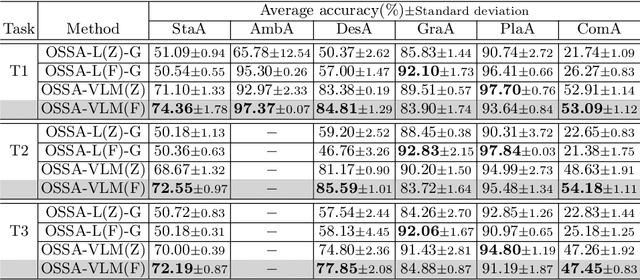
Abstract:The state of an object reflects its current status or condition and is important for a robot's task planning and manipulation. However, detecting an object's state and generating a state-sensitive plan for robots is challenging. Recently, pre-trained Large Language Models (LLMs) and Vision-Language Models (VLMs) have shown impressive capabilities in generating plans. However, to the best of our knowledge, there is hardly any investigation on whether LLMs or VLMs can also generate object state-sensitive plans. To study this, we introduce an Object State-Sensitive Agent (OSSA), a task-planning agent empowered by pre-trained neural networks. We propose two methods for OSSA: (i) a modular model consisting of a pre-trained vision processing module (dense captioning model, DCM) and a natural language processing model (LLM), and (ii) a monolithic model consisting only of a VLM. To quantitatively evaluate the performances of the two methods, we use tabletop scenarios where the task is to clear the table. We contribute a multimodal benchmark dataset that takes object states into consideration. Our results show that both methods can be used for object state-sensitive tasks, but the monolithic approach outperforms the modular approach. The code for OSSA is available at \url{https://github.com/Xiao-wen-Sun/OSSA}
Large Language Models for Orchestrating Bimanual Robots
Apr 02, 2024Abstract:Although there has been rapid progress in endowing robots with the ability to solve complex manipulation tasks, generating control policies for bimanual robots to solve tasks involving two hands is still challenging because of the difficulties in effective temporal and spatial coordination. With emergent abilities in terms of step-by-step reasoning and in-context learning, Large Language Models (LLMs) have taken control of a variety of robotic tasks. However, the nature of language communication via a single sequence of discrete symbols makes LLM-based coordination in continuous space a particular challenge for bimanual tasks. To tackle this challenge for the first time by an LLM, we present LAnguage-model-based Bimanual ORchestration (LABOR), an agent utilizing an LLM to analyze task configurations and devise coordination control policies for addressing long-horizon bimanual tasks. In the simulated environment, the LABOR agent is evaluated through several everyday tasks on the NICOL humanoid robot. Reported success rates indicate that overall coordination efficiency is close to optimal performance, while the analysis of failure causes, classified into spatial and temporal coordination and skill selection, shows that these vary over tasks. The project website can be found at http://labor-agent.github.io
Causal State Distillation for Explainable Reinforcement Learning
Dec 30, 2023



Abstract:Reinforcement learning (RL) is a powerful technique for training intelligent agents, but understanding why these agents make specific decisions can be quite challenging. This lack of transparency in RL models has been a long-standing problem, making it difficult for users to grasp the reasons behind an agent's behaviour. Various approaches have been explored to address this problem, with one promising avenue being reward decomposition (RD). RD is appealing as it sidesteps some of the concerns associated with other methods that attempt to rationalize an agent's behaviour in a post-hoc manner. RD works by exposing various facets of the rewards that contribute to the agent's objectives during training. However, RD alone has limitations as it primarily offers insights based on sub-rewards and does not delve into the intricate cause-and-effect relationships that occur within an RL agent's neural model. In this paper, we present an extension of RD that goes beyond sub-rewards to provide more informative explanations. Our approach is centred on a causal learning framework that leverages information-theoretic measures for explanation objectives that encourage three crucial properties of causal factors: \emph{causal sufficiency}, \emph{sparseness}, and \emph{orthogonality}. These properties help us distill the cause-and-effect relationships between the agent's states and actions or rewards, allowing for a deeper understanding of its decision-making processes. Our framework is designed to generate local explanations and can be applied to a wide range of RL tasks with multiple reward channels. Through a series of experiments, we demonstrate that our approach offers more meaningful and insightful explanations for the agent's action selections.
Enhancing Zero-Shot Chain-of-Thought Reasoning in Large Language Models through Logic
Sep 23, 2023Abstract:Recent advancements in large language models have showcased their remarkable generalizability across various domains. However, their reasoning abilities still have significant room for improvement, especially when confronted with scenarios requiring multi-step reasoning. Although large language models possess extensive knowledge, their behavior, particularly in terms of reasoning, often fails to effectively utilize this knowledge to establish a coherent thinking paradigm. Generative language models sometimes show hallucinations as their reasoning procedures are unconstrained by logical principles. Aiming to improve the zero-shot chain-of-thought reasoning ability of large language models, we propose Logical Chain-of-Thought (LogiCoT), a neurosymbolic framework that leverages principles from symbolic logic to verify and revise the reasoning processes accordingly. Experimental evaluations conducted on language tasks in diverse domains, including arithmetic, commonsense, symbolic, causal inference, and social problems, demonstrate the efficacy of the enhanced reasoning paradigm by logic.
 Add to Chrome
Add to Chrome Add to Firefox
Add to Firefox Add to Edge
Add to Edge